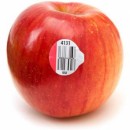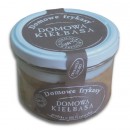
The labels on the jars, labels on products, labels on milk.
The main function of these labels that provide information about the product and a decorative feature - decorating. Often these labels are placed additional CHARACTERISTICS such as expiration date, series and product number. The most important feature that distinguishes the labels on products (such as jars and milk) is the use of special punches (knife cutters). Sample labels are shown in the pictures and have a size of 67x207 mm. The key is to "labels on products" are attractive in appearance. The label on the jar should be designed so that in effect, to emphasize and highlight the quality of the product, which uniquely identifies.
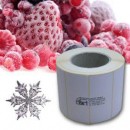
Labels for frozen products (for deep-freezing) are often used in the food industry with products stored at temperatures below 0 degrees C. Due to the nature of packaging used for medicines, it is vital importance that the information on the labels remain intact especially at such low temperatures. Due to the nature of the glueing agent, freezing significantly increases the adhesion of the labels. This type of labels are most suitable for certain flexible packings at low temperature and high humidity.
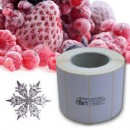
Labels for frozen products (for deep-freezing). Are often used in the food industry with products stored at temperatures below ZERO degrees C. Due to the nature of the glueing agent, freezing significantly increases the adhesion of the labels. Due to the nature of packaging used for medicines, it is vital importance that the information on the labels remain intact especially at such low temperatures. This type of labels are most suitable for certain flexible packings at low temperature and high humidity.

White & coloured labels in contact with food. With this type of labels is essential to determine in what way they come in contact with the product. This contact can be direct or indirect (through packaging). These labels can be certified glueless or adhesion included, which is intended for food contact. Direct labeling of foods are subjected to a number of requirements and regulations. The relevant requirements are contained in the EU Directives. These requirements apply in the first place to paper or other surface materials, which must be certified to be used for direct contact with dry, moist or greasy food. The same applies for special adhesives. In Europe there are special directives for the labelling of vegetables, fruits, meat and sausages. For the labeling of fruit and vegetables a special designed HOT-MELT adhesive based on synthetic rubber and emulsion acrylic adhesives on a very thin surface material of paper or synthetic films are used. In the food industry paper labels and foil products and packaging is most often used. Meat products use similar materials as are used for fruits and vegetables. Most are using labels of PP and PE without using glue. Large quantities of labels are printed in flexographic technology in full color.
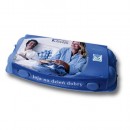
The labels on the package wrappings for eggs. BART Printing offers high quality color labels on the packaging. Our main goal is quality and appearance of the boxes. We make every effort to pack the eggs were aesthetic and to attract the attention of customers.
We colored labels, boxes of eggs, packaging, trays located:
- 4, 6, 9, 10, 12, 15, 18 pieces of eggs
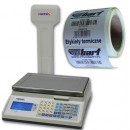
These labels come on rolls, also called weight - price label. This is a form of self-adhesive label used worldwide to determine the mass and food prices. Label specifying the price and weight of the product are now printed on adhesive and heat-sensitive materials (for thermal printing). Due to the heat-sensitive coating the impact of heat serves as activation to reproduce printed information including the barcode. A special weight thermosensitive paper is used (ECO TOP) Duplicators black.
For printing labels, thermal weight and price are used various printers coupled with the weight.
The most popular dimensions are 32x20, 50x30, 50x40 (weight DIGI), 55x20, 57x34, 57x45 (weight Medes), 58x59, 6 (58x60), 60x20, 60x22, 60x25, 60x30, 60x49, and many other types of electronic scales to the Medes, DIGI , CAS, OPTIMUS.
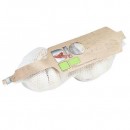
FruitTag tags are used to mark food products: vegetables and fruits, in the food industry. They are made of laminate in which one of the layers is thermal for label printers and embossing machines - packing in raschel bags. FruitTags are very strong adhesive-free labels, wound on rolls. Their shape is formed using special dies and can be arbitrary. These tags are made of 2 layers of special material - polypropylene film and thermal paper. FruitTag also called WineGLASS have a certificate for contact with food. Fruit Tags can be printed using UV flexographic technique. A necessary condition is to use special food contact inks that have low migration. The thermal layer of the tag allows customers to print additional product information on a thermal printer (expiration date, batch series of goods, variety). The disadvantage and limitation of the label is the thermal layer, which should be avoided moisture and exposure to sunlight because it will cause yellowing of the paper. BART printing house tries to deliver the highest quality product with the smallest amount of ribbon connections.
APPLICATION OF FRUITTAGS: Intended for the food industry. It is most commonly found as a label for garlic, onions, vegetables and fruits. Due to its natural durability, it can serve as a handle for carrying. The most common print on Fruittags is: company logo, product name, certificates eg Polish product and eco euroleaf certificate, manufacturer data correspondence data.
Popular dimensions are: 40x142.8; 40x154; 40x308; 40x400
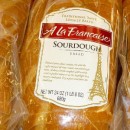
Self-adhesive white and colored paper labels wound on rolls, for bakeries, bakers and confectioneries (confectionery) in the food industry. Applied to packaged bread, bread packaging with breadcrumbs. Appropriate materials are used to mark bread and bakery products. Due to the shapes of the packaging, paper labels that fit well on curved surfaces are used. The most commonly chosen are cheap standard adhesives with a certificate for contact with food, sometimes stronger rubber adhesive. The initial background print is most often made using flexographic technique in a label printing house with a color company logo. Additional prints can be made within your range on label printers. Labels in small and medium quantities are most often applied manually or using manual label applicators. For larger quantities of labels, they are applied using professional automatic label applicators. Bakeries and confectioneries use unusual label shapes to distinguish their products and attract customers. The surface of the printed color ink label should be protected against abrasion using UV varnishes from a roller e.g. glossy, matte or selected using polymers. Prints on labels should be printed with low-migration inks for food contact, although they are not directly applied to bread but to foil packaging. Labels for bakeries are usually cheap, in large quantities, made of TOP or ECO thermal paper. Recently, raw materials made of BIO or RECYCLING material have become increasingly popular. Food product manufacturers often emphasize their uniqueness by refining labels using coldstamping cold lamination.
Popular dimensions of bread labels: 54x95, 60x90, 60x99.5, 68x99, 68x125 , 70z90 , 70x100, 76.6x119.6 , 78x99, 80x100, 100x130.
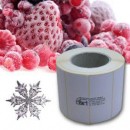
Labels for frozen products for deep freezing. They are most often used in the food industry with products stored at low temperatures (often below zero degrees Celsius). Due to the specificity of the material being glued, labels for freezing usually have a super durable (super strong) adhesive with significantly increased adhesion as well as an adhesive for frosted surfaces. Such labels are applied to so-called special materials, flexible packaging used at low temperatures and high humidity. Due to the nature of the packaging of medicines (pharmaceuticals) and life-saving agents, special types of labels with the possibility of freezing to low temperatures are also used for their labeling. Thermal TOP labels are often chosen for freezing, as well as thermal transfer labels, whose paper is more resistant to moisture. Due to their properties, thermal transfer labels (pharmalite, pharmamatt, pharmagloss) are a slightly better solution. Food product manufacturers often emphasize their uniqueness by refining labels using cold stamping and cold lamination.
If we say “deep freeze glue”, it means glue that can be applied at a temperature of up to -20C and withstands up to -40C. So the application temperature is crucial here. Ordinary rubber adhesives (RH9X, RH01, FH21, S2045n) should also hold up well at -40C, but they cannot be applied at such low temperatures (respectively 0C for RH9X and -5*C for RH01). For frosted surfaces, these adhesives are already a higher shelf, also in terms of price e.g. RH03 and C2075n. Of course, everything depends on how much frost is on the labeled surface. If there is too much of it, then we try to stick the label to the ice rather than the packaging - in such a case even these adhesives will not work.

Labels for the meat industry are used to mark meat products and packaging in the food industry. Labels are supplied on rolls. These can be self-adhesive colored labels or simple white cheaper labels. Colored labels distinguish a given product along with the packaging on which they are affixed. Such food labels may have indirect contact with food through packaging. Very simple white labels with black print serve for precise information on content and weight. White labels made of the appropriate material can be applied directly to animal carcasses. In this case, the top material of the labels should contain appropriate certificates for direct contact with food. These labels are printed using flexographic technique with special food contact inks.
WHITE MATERIALS APPLIED TO CARCASSES.
This is a novelty on the market. Labels applied to animal carcasses serve an informative function. They contain a special top material and ADHESIVE that has been specially designed for direct contact with dry, wet and fatty food. This adhesive occurs in a configuration with a top material specially designed for this purpose. It contains ISEGA certificates and meets EN 1230-2 standards (Robinson test for tastelessness). The minimum labeling temperature is 5 degrees, the minimum temperature after labeling is -20 degrees C, and the maximum temperature after labeling is 100 degrees C. It has a 2-year warranty. The recommended top material is made of film.
TEMPERATURES:
-
minimum labeling: -15
-
minimum after labeling: -50
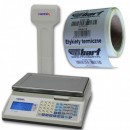
A label for scales is also called a price-weight label. A price-weight label is an informative self-adhesive label used worldwide to mark the weight and price of food products in the food industry. Labels specifying the price and weight of a product are currently printed on thermo-sensitive self-adhesive materials designed for thermal printing. The thermo-sensitive coating requires only heat to activate its surface and reproduce the printed information along with the barcode. To make price-weight labels, special black-copying thermo-sensitive ECO and TOP thermal papers are used. Various types of printers coupled with scales are used for thermal printing of price-weight labels. Price-weight labels are mainly used in retail trade, wholesale trade and industry. These areas of application impose appropriate requirements on self-adhesive adhesives. Therefore, ADHESIVES are used: durable for direct and indirect contact with food and durable and removable without certificates for contact with food.
The most popular dimensions are 32x20, 50x30, 50x40 (weight DIGI), 55x20, 57x34, 57x45 (weight Medes), 58x59, 6 (58x60), 60x20, 60x22, 60x25, 60x30, 60x49, and many other types of electronic scales to the Medes, DIGI , CAS, OPTIMUS.
Price and weight labels are used primarily in retail and wholesale trade and industry. These areas impose appropriate requirements klejom adhesive. Therefore, permanent adhesives are used to direct and indirect contact with food and equipment and removable without additional contact with food.
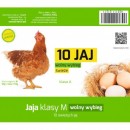
BART Printing House offers high-quality color labels for packaging, popularly called “embossed labels”. Our main goal is to combine high-quality box packaging and labels. We make every effort to ensure that egg packaging is aesthetic and attracts the attention of customers/consumers. In the case of egg packaging, BART Printing House customers focus primarily on ensuring that the final product - the embossed egg label - is perfect in every way. Not only price but also speed of order execution, precision of label application, print quality and good cooperation with the supplier of this complex solution are important. Recently, constructions with biodegradable adhesive have appeared on the market. These labels are usually made of paper, wound on rolls, and sometimes have blow-out cuts.
BART Label Printing House also produces popular paper labels called “price tags”, which are used to mark expiration dates. The most popular size is 32x20 mm. and the material is glossy GLOSS paper, matte MAT or thermal ECO.

BANDEROLE - labels for preserves and jars. These are usually paper labels with standard adhesive wound on rolls. Specialist dies (cutting knives) are used for these labels. The most important feature of product labels is their visual attractiveness. The sticker should be designed in such a way as to emphasize and distinguish the product it identifies. It is worth reading our guide on creating a brand. Professionally designed packaging and a consistent label allow the consumer to remember the image of a good and tasty product. In addition, attention can be drawn by means of information such as patriotic PRODUCT OF POLAND or ecological BIODEGRADABLE PACKAGING.
APPLICATION OF LABELS (read more)
Their function is often informative and decorative, but they are also used as closures for sealing packaging. Additional information such as serial number or expiration date is often printed on these labels. Such printing is done either on label printers and resin ribbons or using so-called inkjet printers mounted on applicators on the production line.


















